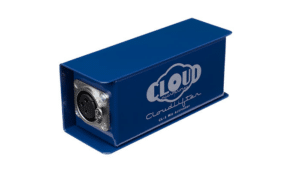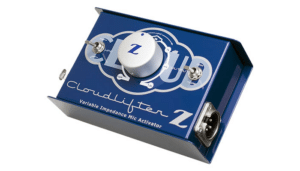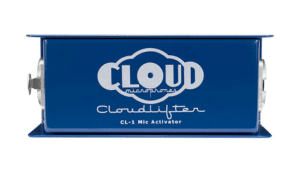When broadcasting, streaming, or capturing vocal tracks, it’s common to run into some signal gain problems. This is especially true with dynamic and ribbon microphones, as they are not as sensitive as other types, such as condenser mics.
A standard-issue Dynamic mic can be used for pretty much anything. They are often used in studios for recording podcasts, voiceovers, and musical instruments. They’re loved because they are durable, handle loud sounds easily, and don’t require phantom power.
A Condenser mic requires some current to create a charge difference within it. This current allows the mic to create a much stronger output level than a dynamic microphone. However, the current has to come from somewhere. If it’s provided by an audio cable (like an XLR cable), then it is known as phantom power.
Industry-favorite dynamic microphones like the Shure SM-7B, Electrovoice RE-20, and Rode Pod are popular for recording vocals because they cushion voices with a warm presence while making them sharper and more intelligible. They’re also good at filtering room ambiance and external noise. However, many users agree that the volume can be rather low. This is because low output dynamic microphones, especially the high-end ones, have a lower output than most microphones. This means that the mic requires a lot of gain to capture audio properly.
Sound engineers and audio experts agree that the output of a microphone should hover around -20dB and -5dB. The Shure SM7B has an output of -59 dB. It would be significantly quieter than most other microphones unless extremely amplified.
So, we believe that Shure SM7B with Cloudlifter is a must-have bundle if you want a better performance from your mic!
Most preamps are designed for more sensitive condenser microphone outputs and usually don’t have the juice to provide enough sufficient gain for low output mics. Even if the preamp can, you’ll find yourself cranking the maximum gain too hard to get useful sound. Often leading to distortion and artifacts.
There are many ways to boost gain, but there are only a few ways to do it in a way that preserves the purity and overall audio quality. One of the most popular of these few ways is using a Cloudlifter.
So what does a Cloudlifter do? If you’ve been dealing with popular dynamic or ribbon mics, chances are you’ve already heard of a Cloudlifter. However, you may wonder if you should get one or even need one at all. In this guide, we’ll answer all the questions you may have about Cloudlifters.

A Cloudlifter is a microphone booster or activator that boosts the gain of low output mics that don’t use phantom power or use their own power supply. Produced by Cloud Microphones, Cloudlifters were borne out of frustration by Roger Cloud trying and failing to boost a low-output passive ribbon mic. It is an active amp that provides the mic signal with a boost before it reaches the preamp, as well as appropriate impedance loading for dynamic and ribbon microphones to function at their best.
All you have to do is plug in your dynamic or ribbon microphone to the input and a mixer or preamp to the output. The rest is taken care of by the Cloudlifter.
The Cloudlifter is a fully discrete device with no resistors or capacitors in the audio path, built into a solid steel case with Neutrik XLR connectors.
The Cloudlifter is not a preamp, although it is common for it to be called that. It boosts volume just like a preamp but does this through drawing power from a preamp.

The most commonly used are the single-channel CL-1, dual-channel CL-2, and single-channel CL-Z, which feature switches for variable impedance and high pass filters.
You can think of a Cloudlifter as a step before the preamp. The Cloudlifter works by converting phantom power into ~25 decibels of gain. Its revolutionary discrete JFET circuitry allows you to up your levels significantly without any hits to the overall audio quality of your sound. They’re designed to be used in tow with low-signal dynamic and passive ribbon mics.
It is common for preamps to sound great until you push them, resulting in hiss and crackle appearing in the mix. Using a Cloudlifter allows your mic preamp to run at a much lower gain setting. Running it at a lower gain can make the difference between clean, electrically silent audio and one assailed by noise and clips.
In addition, the gain boost provided by your Cloudlifter lets your mic work more efficiently and ensures that there is enough room for extra gain to be added while mixing. This means that you get all the audio levels you need without too much noise.
Yes, Cloudlifters can only function using 48v phantom power and have no means or need to use batteries. It can get draw phantom power from a mic preamp, mixer, audio interface, or anywhere along your signal chain. If you want, you can also use an external phantom power unit. When it gets its power, it doesn’t pass it down the chain into the microphone, so it is safe to use with dynamic and ribbon microphones. However, you can damage a ribbon mic with phantom power.
If you work in a large studio or an auditorium with many wires in your signal chain, a Cloudlifter can improve your sound and preserve it from the sound decay that comes with hundreds of feet of cable.
You don’t use Cloudlifters with condenser microphones. Condenser mics need phantom power to work, and the Cloudlifter doesn’t share any of its phantom power with the microphone it is being used with, so a condenser microphone simply will not work. Condensers don’t need a gain boost anyway unless something is lacking with your preamp or something else along your setup.
Like I said earlier, there are many ways to boost your gain, but if you want to hear more of your dynamic or ribbon mics’ character and clarity with a clean gain boost, then a Cloudlifter should do the trick.
Cloudlifters are affordable and will set you back about $150. They also come with a lifetime limited warranty for original owners if you run into any faults or bugs.
They’re also energy-efficient, requiring only phantom power from devices along your audio chain. If you can’t get phantom power from your preamps, and other devices or you don’t want to, you can get an external phantom power unit for your Cloudlifter device.
Cloudlifters are also of a simple build and are very easy to use. They’re a steel box with a couple of cable outlets and two connectors per channel.
Then there’s the difference in sound quality. The voice on the Cloudlifter track has more weight and can preserve the natural elements of your source better than other gain-boosting options.

Using a Cloudlifter is so straightforward that I don’t think it’s possible to get it wrong. All you need are two XLR cables. One XLR cable from the microphone to your Cloudlifter. One XLR cable from your Cloudlifter to your preamp or audio interface. After which, you can turn on phantom power, and you’re ready to start recording.
To answer this, there are a few things you’ll need to consider.
Earlier on, we explained how condenser microphones are incompatible with Cloudlifters. So if you’re having preamp gain problems with a condenser microphone, your solution lies somewhere else, sorry. Cloudlifters only work with a dynamic microphone or a ribbon mic.
The next thing you want to check is the sensitivity level of your microphone. The most typical use of a Cloudlifter is to compensate for a low-sensitivity microphone or achieve more gain than your preamp can deliver on its own. A microphone’s sensitivity indicates how much electricity is generated at a given pressure level. When turning pressure waves into electrical currents, some microphones are more efficient than others. So if you use a microphone with low sensitivity like the Shure SM7B (a broadcast dynamic mic famous for the godlike tone it gives users but notoriously weak output), you’ll most likely need to use a Cloudlifter.
What are you using the mic on? What or where is the sound coming from? Musical instruments are generally loud, so if you’re using a mic on one, you may not need a Cloudlifter.
On the other hand, you may need to use it if you’re recording just your voice. This is because human voices are usually lower in tone than a guitar or a saxophone.
Due to the inverse distance law, the distance of the sound source from the microphone also matters. There is a 6 dB reduction in level for every doubling of the distance between the source and the microphone. Because of the proximity effect, moving closer to the microphone increases the loudness, but it also changes the tonal balance of the signal. You’ll need a Cloudlifter if you can’t achieve a good level from approximately 3 inches away from the microphone.
The preamp gain levels of some amplifiers are rather low, requiring you to turn the gain to the maximum every time you need useful sound. When you turn your preamplifier all the way up, you will hear some noise in the background of the finished recording. By using a Cloudlifter, you can reduce your noise floor. All you have to do is increase the microphone signal level before it gets to the preamplifier. This way, you won’t have to turn it all the way up.
The good news is that most of the recently made preamplifiers come with a really low noise floor, so you may not need to get a Cloudlifter at all.
The Cloudlifter CL-1 is $149 in all authorized online stores. If you can afford to buy it, you should go right ahead. It is a useful piece of equipment that can help you make more engaging, natural-sounding content.
However, if you’re just starting out, you may want to hold on and get a better feel for your options before you get it. We recommend using your available gear to the best of your ability before getting other equipment that may only marginally satisfy you. Then, as you progress, it’ll be easier to figure out precisely what you need and can invest in them as required.
That said, there are more affordable alternatives to a Cloudlifter that claim to be as good or even better. I’ll take the liberty to cover them below.
The Cloudlifter was the first commercially-available device of its kind that we were aware of, so the term Cloudlifter has become something of a generic term for that kind of level booster.
However, thanks to the continuous growth of technology, we now have other products that work the exact same way and can be used as alternatives to a Cloudlifter.
There are a handful of these in the market today, so if you want to learn more about them, head over to our article that covers all about Cloudlifter Alternative in one blog.
A Cloudlifter isn’t a preamp in the traditional sense. Mic activators, mic boosters, inline preamps, and pre-preamps are all terminology that have been used to describe it, but it doesn’t really fit in any of those categories. It increases loudness by taking power from the preamp, specifically phantom power, just like a preamp does. You get all the capability of a preamp without any potential distortion or coloring by increasing the signal level with clean, transparent gain.
If you’re a podcaster or voiceover artist looking for a portable addition to your studio or podcasting setups to maximize sound, a Cloudlifter should be useful to you. This handy equipment ensures you get clean levels anywhere.
As mentioned above, there are a few things you need to consider before you decide if a Cloudlifter is really what you need. Your microphone type and budget are of particular importance here, so carefully consider each of those things before deciding.